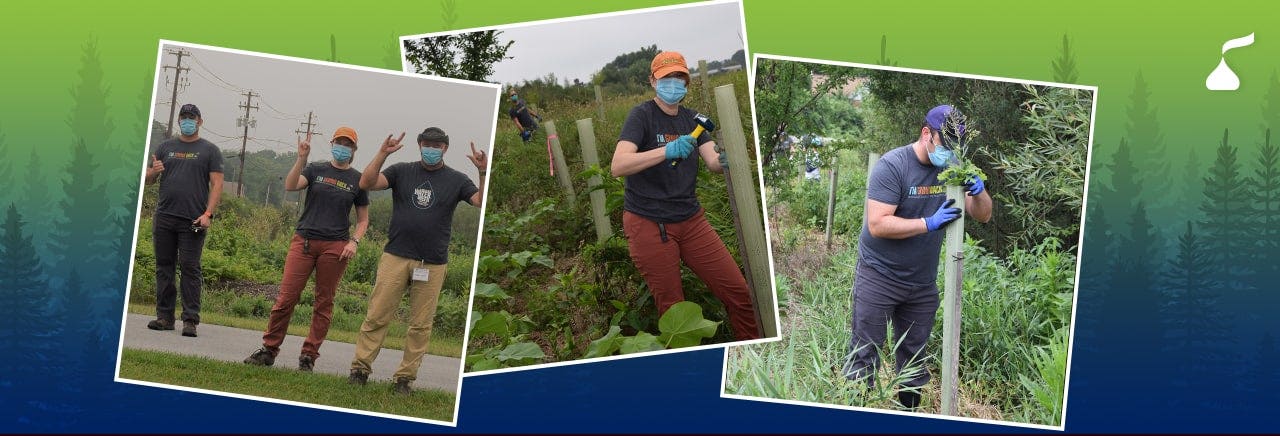Environment
Protecting Our Planet’s Resources and Safeguarding Our Future
We at Hershey have always said that doing good by the Earth is not only doing the right thing – it’s good business. That statement is as true today as it was when Milton Hershey first said, “There’s not a person alive who should not plant a tree. Not for the shade that you’ll enjoy, but for those coming after.”
Future generations at Hershey and beyond will continue to rely on agricultural commodities grown in healthy soil, rich biodiversity to keep pollinators busy all season long, abundant high-quality water to keep manufacturing our products and clean air to keep employees, communities and consumers within our supply chain healthy and safe.
Climate change, water scarcity, natural resource depletion and biodiversity degradation all pose increasing threats to our planet, communities and individuals around the world. As we face environmental challenges, we see opportunities for collective action by governments, businesses, NGOs and multilateral organizations, and we are committed to doing our part to create positive change for a brighter future.
Addressing Climate Change and Reducing our Environmental Footprint
Climate action is infused across our organization. We are proud to be among the companies committed to the Science Based Targets initiative (SBTi). We have set ambitious, science-based greenhouse gas (GHG) reduction goals to reduce our absolute Scope 1 and Scope 2 emissions by 50 percent and our absolute Scope 3 emissions by 25 percent by 2030 against a 2018 baseline.1 Our emissions reduction targets are aligned with the 1.5°C temperature pathways, the most ambitious designation available through the SBTi process, and consistent with the goals of the Paris Agreement. To meet these ambitious objectives, we have implemented numerous programs to protect our environment for a more sustainable future, including investing in renewable energy, advancing sustainable packaging solutions and ending deforestation across our value chain.
Investing in Renewable Energy
Investing in renewable energy is key to reaching our Scope 1 and Scope 2 commitments. We have reached three power purchase agreements (PPAs) that enable the construction of new utility-scale solar farms. Through these PPAs, we access clean and renewable energy while creating local jobs and generating significant power for the communities where they are located. Additionally, to drive our commitment to renewable energy, each Hershey location around the world has designated an Energy Champion responsible for implementing carbon savings, meeting conservation goals, identifying opportunities for energy reduction and efficiency and engaging employees in these efforts.
Advancing Sustainable Packaging Solutions
In order to reduce the potential negative impacts of plastic waste and waste sent to landfills, we are eliminating unnecessary packaging and converting to eco-friendly alternatives to create a more sustainable future. In 2015, we committed to reducing packaging weight by 25 million pounds by 2025. We’re proud to say we’ve surpassed this goal and have set a new goal of reducing an additional 25 million pounds by 2030. We’re also aiming to make 100 percent of our plastic packaging recyclable, reusable or compostable by 2030.
Ending Deforestation
We are committed to ending deforestation across our supply chain by 2030 by working within our individual commodity supply chains to drive sustainable practices across our supply chain. Our No Deforestation Policy commitment is a key part of Hershey’s efforts to meet our Scope 3 commitment. Read more about this commodity-specific approach to ending deforestation in our Cocoa Forest Initiative Report.
Protecting Biodiversity
Hershey recognizes that biodiversity plays a critical role in business success and in safeguarding the health of our planet and communities. We have deeply embedded biodiversity within our environmental policies, including our Environmental Policy and No Deforestation Policy. Through ongoing interactions with farmers and other suppliers, we invest in and work toward protecting the ecologically important ecosystems where our cocoa is sourced and where our palm oil is produced.
Protecting Water Sources
As a global snacking company, water is critical to our business and interconnected to our climate action strategy. In 2020, we joined the Science Based Targets Network’s (SBTN) Corporate Engagement Program to stay aligned with emerging best practices in water stewardship. In 2021, we launched a preliminary assessment to better understand our water footprint and gather insights on contextual water challenges across our business. Through continued participation in SBTN’s self-guided pilot, we’ve continued to take important steps to integrate water quality and quantity awareness across our supply chain. We will continue to report on our progress in our annual sustainability report and on our website.

Engaging employees to achieve our climate action goals
The ambitious goals we’ve set to take action against climate change will require support from our passionate employees, including an employee-group dedicated to creating a more sustainable Hershey, Green Teams. Green Team groups exist in our many locations around the world to activate on sustainability projects, including a native tree giveaway through a partnership with the Arbor Day Foundation.

Bringing a Passion for Environmental Sustainability to Hershey: A Company that Cares to Make a Difference
At Hershey, we have numerous programs to protect the environment and make a difference. These programs include collaborations and partnerships around the world, as well as Hershey employee events like native tree plantings. We have set ambitious science-based targets to reduce our greenhouse gas footprint aligned with the 1.5°C temperature pathways for a better future.
Resources
Resources
1 Scope 1: Direct GHG emissions occur from sources that are owned or controlled by the company.
Scope 2: Indirect greenhouse gas emissions from consumption of purchased electricity.
Scope 3: Other indirect emissions, such as from the farm-level production of our ingredients, the extraction and production of purchased materials and fuels, transport-related activities, outsourced activities, waste disposal, etc.